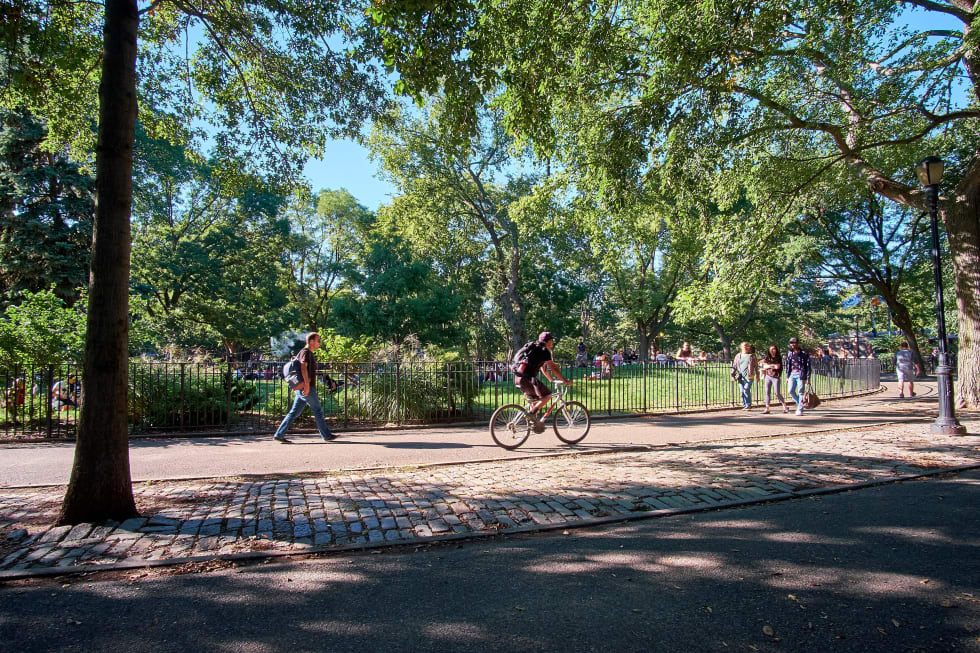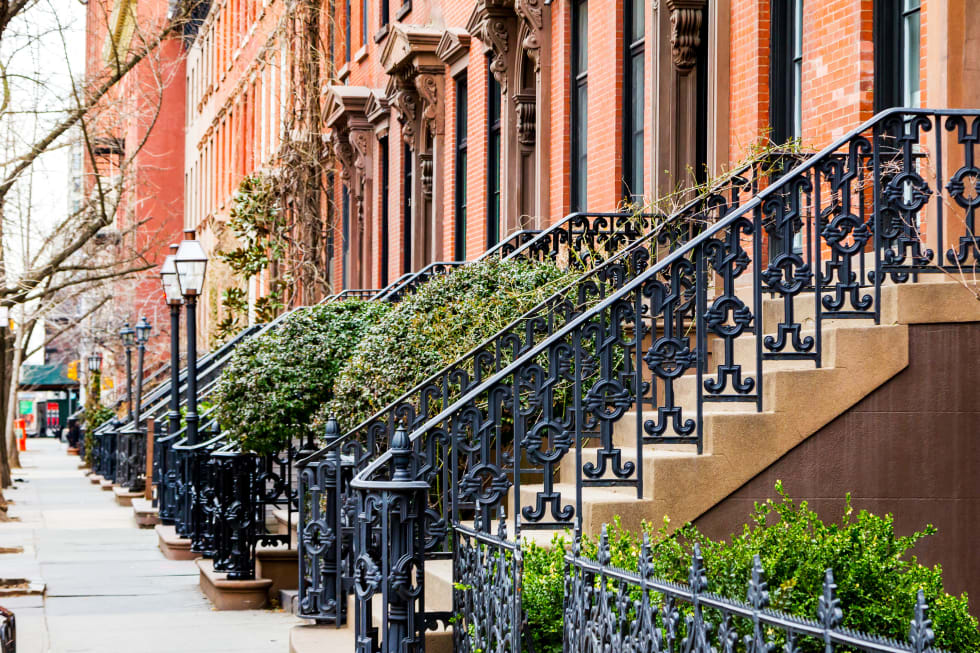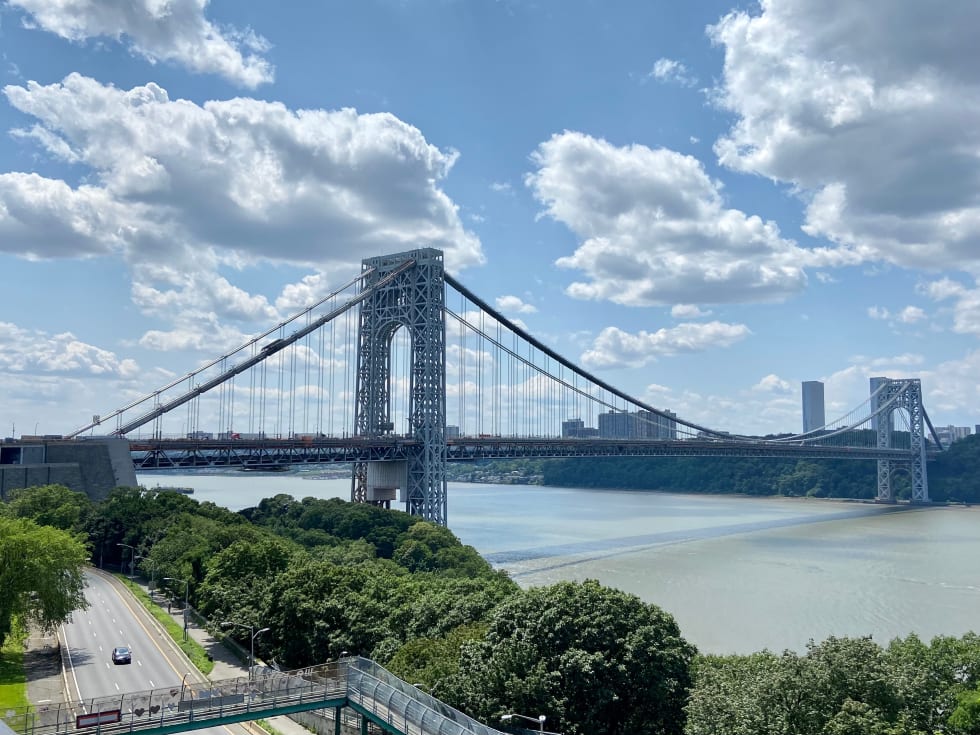How to Find an Apartment in NYC [2024]

Ready to move to New York and soak up the city life? The Big Apple is filled with eclectic neighborhoods, restaurants, pubs, shopping, and museums that offer something for everyone. It’s easy to get overwhelmed in a city that never sleeps. But don’t worry, we did all the research of where to live to point you in the right direction. Here’s a round-up of the best neighborhoods in New York and learn which one is right for you!
How to Find an Apartment in New York City
How Much Is Rent in NYC?
As of May 2024, the overall median rent in NYC is $2,302 a month, making New York City the tenth most expensive large city in the United States for renters. For a one-bedroom, expect to pay a median rate of $2,197, and for a two-bedroom, most renters will shell out around $2,317 a month.
How to Find the Best Neighborhood in NYC
As you've probably heard, NYC is split into five main "boroughs," all of which feature their own distinct neighborhoods. Rental prices, lifestyle, commuting options, and other factors all fluctuate greatly between boroughs and neighborhoods. Here are some of our favorite areas of NYC's most iconic borough, Manhattan. We have even more to choose from in our longer guide to the best NYC neighborhoods.
Please note that the rental estimates below reflect current listings on our website.
1. Lower East Side
- Average one-bedroom rent: $3,980
- Map of Lower East Side
Average rents in the Lower East Side (LES) vary, but you can expect to pay around $4,000 a month. This eclectic NYC neighborhood is filled with tons of history. Once a hot spot for European immigrants during the late 19th to early 20th centuries,historical tenement buildings in the neighborhood still remain. The LES is still a vibrant neighborhood with lots of great live music, trendy bars, fantastic nightlife, art galleries, and a Jewish community. You can see some of the history at the local Tenement Museum.
The Lower East Side is also adjacent to Chinatown, Little Italy, and Soho, making it a great location for exploring other New York neighborhoods. Brooklyn is just a few subway stops away. If you want to stay in the neighborhood, catch a show at the nearby Bowery Ballroom or get intouch with your youth at Two-Bit's Retro Arcade.
The Lower East Side is well connected to the rest of the city and a convenient location for students of NYU, creatives at heart, and career climbers. You can take the subway to one of the many train stations, including East Broadway, Delancey St-Essex St, and Grand Street. If you’re feeling ambitious, it’s easy enough to walk to the East Village, Soho, or the West Village.
The Lower East Side is considered safe, although if you come home late from a music venue or bar, it's recommended to exercise some caution.

2. East Village
- Average one-bedroom rent: $3,758
- Map of East Village
East Village rents are on the rise at an average of $4,525 a month. This lively New York neighborhood offers a creative, energetic energy with plenty of pubs, restaurants, and shopping.The East Village is also home to the famed St. Mark’s Place and where you’re never far from fun bars, shops, nightlife, street vendors, and karaoke.
Home to New York University, the East Village is home to students and young professionals alike. You’ll feel at home whether you’re just starting your career or looking for a new adventure. The East Village has seen waves of gentrification, but still retains a grittier vibe than upper Manhattan neighborhoods.
It's easy to walk from the East Village to Union Square, the Lower East Side, and Soho. Or you can take the subway to Astor Place, 2nd Avenue, and 14th St-Union Square to connect most anywhere in the city.
The East Village is a safe place to live, although it can get noisy if you live near bars and restaurants. It's wise to pay attention to your surroundings as you head into Alphabet City at night, although the overall crime rate remains low.

3. Greenwich Village
- Average one-bedroom rent: $5,027
- Map of Greenwich Village
Greenwich Village is the home of the iconic Stonewall Inn, a gay bar and National Historic Landmark, was the sight of the 1969 riots that launched the gay rights movement. Greenwich Village. It's also where the famous apartment from the TV show "Friends" was supposed to be located. Today, Greenwich Village is a lively, centrally-located neighborhood that’s popular with just about every demographic from NYU students to families to retirees.
Locals have their choice of subway stops at W 4th St - Washington Square Park, Houston St, and 14th St. It's also walkable to Soho, Union Square, and the East Village.
Greenwich Village is considered among the safest places to live in the city. Your neighbors include everyone from celebrities to CEOs enjoying this gorgeous neighborhood all hours of the day and night.

4. Manhattanville
- Average one-bedroom rent: $3,800
- Map of Manhattanville
Also known as West Harlem, Manhattanville is a cozy neighborhood known for its industrial vibe mixed with residential areas. Rents vary in Manhattanville, but are a bargain for Upper Manhattan neighborhoods. Although rents average $3,000 to $4,000, it’s still possible to find prices under $2,000.
The area of Manhattanville spans between 96th and 155th, and Frederick Douglass Boulevard and the Hudson River. You'll also find smaller enclaves that are often considered part of West Harlem, including Hamilton-Heights, Sugar Hill and Morningside Heights.
Like most of the city, Manhattanville is undergoing gentrification that’s been amplified by Columbia University’s expansion into the neighborhood. Depending on who you ask, locals are either weary or welcoming of the changes. It’s also an incredibly convenient location for Columbia’s students and staff to call home.
Despite its industrial roots, Manhatanville enjoys spectacular greenspace at The West Harlem Piers Park and Riverside Park. After a day in the urban grind, you can fish, kayak, or just enjoy being outdoors near the Hudson River.
Manhattanville’s subway is available at Broadway and 125th Street. Most of the area is considered safe with residential streets and gorgeous brownstones. You shouldn't have much problem, even after dark, but it's still not a good idea to wander around at night.

5. Battery Park City
- Average one-bedroom rent: $4,756
- Map of Battery Park City
Battery Park City is home to posh highrises overlooking the Hudson River. It’s a quiet New York neighborhood within walking distance of Wall Street, making it an ideal location for finance professionals. Rents average around $4,991, but you’ll pay a premium for living in a high-rise near the waterfront.
There’s not much nightlife to speak of around Battery Park, but there are a number of restaurants, grocery stores, cinemas, and cafes. You get a “small town” vibe while still being adjacent to the hustle and bustle. More than one-third of the area is parkland with gorgeous views of greenspace and the Hudson.
If you want to work in Battery Park City, you're in good company. The financial district is minutes away where you can work on the trading floor on nearby Wall Street or City Hall. Battery Park City is also home to hospitality stops and area attractions like the Museum of Jewish Heritage and South Street Seaport Museum.
Locals get around the city by taking the subway station to South Ferry - Whitehall St. There are also nearby options in the Financial District, like the Wall St stop. Or choose a number of water-transportation options including ferries to New Jersey and Staten Island and pricier water taxis.
Battery Park is considered very safe, especially considered its lack of bustling nightlife. You'll see families, joggers, tourists, dog lovers and executives out during the day. At night, most people enjoy dining or soaking up the views of the Hudson from their apartment.

2. What’s the Best Time to Find an Apartment in NYC?
According to the rental pricing data that Apartment List has collected over the past few years, New York City rents have historically been lowest in January and February. That is consistent with national trends that show rental prices dip across the country in the winter months. Conversely, rents have been highest in NYC in August and September.
Many renters choose not to move in winter because of the chance of inclement weather and also because it's mid school-year. However, the winter months are your best time to find deals on rent. The summer, by contrast, will generally see more availability. So the "best time" to rent depends on whether you're looking for better deals or more selection.
3. How to Budget for Your NYC Apartment
Where you live in NYC is almost certainly going to be determined by your rental budget. The recommended 30% rule is one method you can use to calculate your rental budget. According to the 30% rule, your rent should not take up more than 30% of your gross income or pre-taxed monthly take-home pay.
An example of the 30% rule would be looking for a one-bedroom apartment in NYC with an median rent price of $2,302. Based on this rule, your gross income should be about about $90,000 annually to afford an apartment in the city.
The 30% rule is designed to help you cover your necessary expenses and set aside some savings. These typical expenses tend to include:
- Rent
- Cable/internet
- Heating and gas
- Electricity
- Car payments
- Groceries
- Savings
As you begin putting your expenses together, you might start feeling a bit overwhelmed. However, there are plenty of ways to reduce your expense. Consider taking advantage of some cost-saving tricks like continually seeking out different move-in specials or being mindful of seasonality when renting.
Understand the Trust Cost of Renting
It’s important to remember that the 30% rule works best as a baseline rather than an exact picture of what your rental budget should look like. The 30% rule does not account for the hidden costs of renting when forming your complete budget for your NYC move. Take a closer look at some of the hidden apartment expenses if you’re wondering how much apartment rent you can afford. Some of the everyday hidden apartment expenses include:
- Move-in fees
- Pet deposit
- Apartment application fees
- Security deposit
- Moving costs
Your specific financial circumstance will also play a factor in determining how much rent you can afford. Additional financial needs, including medical expenses, student debt repayment, etc., may impact your budget drastically, proving that the 30% rule might not quite fit your budget. If this is the case, you’ll have to adjust your budget accordingly.
You can also utilize other helpful tools, such as the Rent Calculator, to determine how much you can afford to pay, including additional expenses. This tool will help you better understand what type of rental budget you are working with for your move to NYC. Best of all, this beneficial tool has been put together with renters like you in mind.
4. Consider Your Commute Time
One of the undeniable advantages of living in NYC is the world class public transit system. The downside to that, however, is the costs of parking are sky high, and availability is low. If you plan to commute to work, you need to carefully plan where you'll live according to whether you'll need a car or public transit. Check out the MTA's Metro Map in order to get an idea of which subway lines are closest to the neighborhoods you're considering.
5. Prepare for Apartment Tours
Before signing a lease for your new NYC apartment, you’ll want to take part in an apartment tour. While it might not seem that important to see a space if you've viewed pictures online, you should be aware that there may challenges (or benefits) that go along with living in a specific location. For instance, you will learn about the neighborhood, the ease of access to the building, and other aspects of the apartment that won't be in pictures but will impact your quality of life. Plus, you can make sure that the apartment matches the description.
Find out how the application process works before going on your apartment tour. You’ll have a better idea of what to expect and know how to prepare yourself this way.
Never feel rushed during your tour and remember to enjoy yourself. Take your time and ensure all the amenities in the listing are functioning correctly. Additional questions you may have about the property that comes up when reviewing the listing can be jotted down and brought with you. Crucial questions about the apartment should include things like painting, pets, and other building rules.
Check out our list of 20 questions to ask when renting an apartment to get a better idea of what you should be asking the property manager during your apartment tour.
6. Applying for Your NYC Apartment
The application process should come relatively easy, considering you already have the necessary materials gathered from your tour. But, in addition to those materials, other things such as rental references may be required for your application.
For rental references, most landlords will want to see previous landlords listed. However, it shouldn’t be an issue if you don’t have any previous rental history. Be sure to clarify ahead of time so you can get your contacts in order since property managers may also accept personal references in some instances.
Either way, make sure you reach out to your rental references ahead of time so that they can anticipate the call. Speed up the application process by giving them a heads-up and allowing them to respond more quickly on your behalf.

7. Protect Yourself from Rental Scams
According to a rental fraud report by Apartment List, 37.2% of renters in NYC have encountered an apartment listing they suspected was fraudulent. Unfortunately, 7.1% of these New York renters have lost money from one rental scam.
Follow these tips for avoiding rental scams to stay on the safe side and keep yourself protected by ensuring you are always cautious.
Finding Your New York Neighborhood
Each area comes with its own character and history. Once you've decided on the best New York neighborhood for you, it’s time to start comparing average rent prices, and examine the cost of living.
Ready to start your apartment hunt? Take our quiz and start narrowing down your wish list of amenities, New York neighborhoods, and rental prices to fit your budget.
Share this Article




